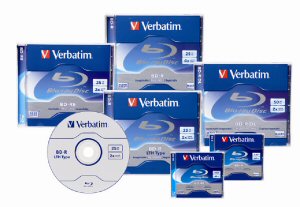 This year, Verbatim celebrates 40 years of enhancing the digital lifestyle of consumers, businesses and professionals with data storage innovation.
This year, Verbatim celebrates 40 years of enhancing the digital lifestyle of consumers, businesses and professionals with data storage innovation.
Since its founding in 1969, the company has been at the forefront in the development of data storage technology – from floppy disks and magneto-optical storage media to the CD and DVD formats and the latest high-definition Blu-ray Disc (BD) media.
In the early years, the company joined industry leaders such as IBM in rolling out the 8-inch floppy diskette, Shugart in announcing the 5.25-inch floppy diskette and Sony in introducing the 3.5” micro diskette (1MB). Focused on increasing its share of the rapidly growing floppy disk market, Verbatim continued to pioneer advancements such as the launch of its high-density 1.6MB mini diskette, its 2MB micro diskette and the DatalifePlus® (Teflon-protected) diskette and soon became the world's largest producer of floppy disks.
While Verbatim had achieved market leadership with floppy disks, it continued to expand its product range, adding 5.25” magneto-optical (MO) media in 1990 and 3.5” MO media in 1991. As the need for higher capacities and higher performance storage solutions grew, Verbatim also took a leadership role in the development, manufacture and advancement of CD and DVD media.
In 2002, Randy Queen, a 20-year veteran with Verbatim, was promoted from vice president of operations to president. Since then, he has guided the growth and expansion of the company beyond optical storage to encompass three additional operating units – hard disk, flash memory and accessory products.
A year after Queen’s appointment, Verbatim launched its award-winning line of Store ‘n’ Go USB flash drives. Currently, Verbatim offers a broad range of USB drives that meet the needs of consumers, professionals and corporations with capacities ranging from 1GB to 32GB.
In addition to the standard applications such as USB drives, digital still cameras, digital camcorders and portable devices, flash storage is now penetrating the computer industry with SSD drives like Verbatim’s recently launched ExpressCard SSD. With capacities of 16, 32 and 64GB, the new solid-state drive (SSD) provides PC and Mac users with plug-in storage that is up to five times faster than USB-based ExpressCards.
In 2004, Verbatim leveraged its leadership in advancing CD and DVD media technology to become the first to launch double-layer optical media. With this milestone, the capacity of DVD media increased to 8.5GB.
Following the launch of its first BD media in 2006, Verbatim became well-known for advancing recordable and rewritable Blu-ray disc technologies. These advancements enable users to benefit from higher speeds, dual layers and printable surface BD media—all with a proprietary, super-hardcoat protective finish developed by MKM.

Verbatim also offers 2X BD-R LTH Type media and will soon launch higher-performance LTH media featuring "Low to High" (LTH) in-groove recording. Compared to standard BD-R discs, which use inorganic dye, BD-R LTH discs use a patented organic AZO layer which Verbatim’s parent company, MKM, developed by drawing on its many years of success in developing organic AZO recording layers for CD-R and DVD-R media. The organic recording layer allows the LTH media to be manufactured on existing CD-R or DVD-R production lines with only minor adjustments, providing a more affordable solution to high-definition video storage.
One of the keys to Verbatim being first to deliver so many new optical media products is its affiliation with its parent company, Mitsubishi Kagaku Media Co., Ltd., (MKM) and the Mitsubishi Chemical Corporation Group (MCC), Japan's largest chemical company. With each performance increase, new manufacturing techniques must be developed in combination with dyes and chemistries that can be reliably written to at extremely high spin rates. As a result, MKM’s and MCC’s outstanding research and development of new dyes, coatings, base media technologies and manufacturing processes has clearly been an advantage for Verbatim.
2007 was also the year that Verbatim purchased substantially all of the assets of SmartDisk Corporation’s external hard drive (HD) and digital imaging business. “Verbatim recognized that consumers and business professionals need the full range of removable and portable storage options – optical, flash and hard disk,” recalled Randy Queen, Verbatim President. “The acquisition was part of Verbatim’s corporate strategy to capitalize on the growing PC external storage market and to complement its existing line of portable storage products.”
With the acquisition of SmartDisk, Verbatim continued to expand its product offerings and moved full-speed into the removable HDD and the consumer/small-medium business NAS markets. Recently, the company added the world’s first half-Terabyte 2.5” Portable Hard Disk Drive (HDD).
Queen, a 20-year veteran with Verbatim, was promoted from vice president of operations to president in early 2002. Since then he has guided the growth and expansion of the company beyond optical storage to encompass four operating units – hard disk, flash memory, accessory products and optical.
Prior to his current position, Queen headed the firm’s global operations group for two years. He joined the company in 1989 as part of the corporate engineering team supporting minidisk manufacturing. In 1991 he moved to Verbatim’s Microdisk subsidiary in Chesapeake, Va. A year later he transferred to the company’s media coating and $&D operation in Sunnyvale, Ca. In 1998 he returned to the firm’s Charlotte headquarters as vice president of technology and business development.

What role has Verbatim played in the removable storage media market?
Since its founding as Information Terminals Corporation in 1969, Verbatim has been at the forefront in the development of data storage technology – from floppy disks and magneto-optical storage media to the CD and DVD formats and the latest high-definition Blu-ray media.
In the early years, the company joined industry leaders such as IBM in rolling out the 8-inch floppy diskette and Shugart in announcing the 5.25-inch floppy diskette. To reflect its expanding product line, the company changed its name to Verbatim in 1978.
Between 1983 and 1987, Verbatim joined Sony in introducing the 3.5” micro diskette (1MB) and continued to focus on increasing its share of the rapidly growing market. During that time, the company launched its high-density 1.6MB mini diskette, its 2MB micro diskette and the DatalifePlus® (Teflon-protected) diskette. Verbatim soon became the world's largest producer of floppy disks.
In the early ‘90s, Verbatim continued to expand its product range, adding 5.25” magneto-optical (MO) media and 3.5” MO media. As the need for higher capacities and higher performance storage solutions grew, Verbatim took a leadership role in the development, manufacture and advancement of CD and DVD media followed by BD, HD DVD and UDO media. The company also saw the need for more portable storage solutions and responded by expanding its offerings to include flash-based products and removable hard disk products.
Today, in its 40th year, Verbatim is known worldwide for delivering the latest storage solutions as well as a full range of accessories with the reliability, performance and broad compatibility resellers and consumers have come to expect from Verbatim brand products.
When did Mitsubishi acquire Verbatim?
Verbatim was acquired by Mitsubishi Kasei Corporation (MKC) in 1990. Five years later, MKC and Mitsubishi Petrochemical Corp. merged to form Mitsubishi Chemical Corp. (MCC). Recognized as Japan's largest chemical company, MCC is composed of more than 40 subsidiaries, including Mitsubishi Kagaku Media Co., Ltd. Verbatim’s parent company.
How did the Mitsubishi acquisition benefit Verbatim?
In the three years following its acquisition by Mitsubishi Kasei, the company introduced more new data storage products than any other company and earned a reputation for being one of the industry's premier media manufacturers.
As part of MKM and the Mitsubishi Chemical Corporation Group (MCC), Verbatim benefits from outstanding research and development on new dyes, coatings, base media and production processes that have enabled so many of the innovations shaping today's storage media market.
Verbatim works directly with the standards groups and leading drive manufacturers to co-develop next-generation removable storage solutions. These co-development efforts and MKM's extensive R&D capabilities have helped Verbatim maintain an unmatched history of being first with the industry's fastest optical media while maintaining its reputation for providing the highest levels of reliability and durability.
What are some of the products that Verbatim was first to launch?
Verbatim's leadership role has been is especially apparent in the evolution of the CD, DVD and BD family of optical products.
In the optical industry, Verbatim is credited for being first to introduce:
- CD-ReWritable (CD-RW) media
- 16x extended-capacity CD-R discs
- 4x-speed DVD+RW media
- 32x Ultra Speed + CD-RW discs
- 8.5GB DVD+R DL media
- Mini DVD+R DL media
- 15GB HD DVD-R recordable media
- Mini DVD-R DL media
- Mini BD media
- Color-background LightScribe DVDRs
- LightScribe-certified 8x DVD+R DL media
What factors have contributed to Verbatim’s dominance in the recordable CD and DVD media markets?
Verbatim/MKM’s worldwide dominance in the recordable CD and DVD media markets can be attributed to a number of factors, including the ability to combine high reliability, stability and longevity with high performance and broad compatibility.
MKM and Verbatim continue to overcome the challenges that each new optical media performance enhancement presents. With each performance increase, new manufacturing techniques for platter flatness must be developed in combination with dyes and chemistries that can be reliably written to at extremely high spin rates.
When did Verbatim expand its product line from magnetic and optical media to flash media?
Recognizing the global increase in digital devices powered by memory chips, Verbatim expanded into the flash memory market in 2001, adding a wide range of memory cards, adaptors and readers. Then, in response to the growing number of people who want to take their data with them wherever they go, Verbatim launched its award-winning line of Store ‘n’ Go USB drives in 2003. Currently, Verbatim offers many different USB drives for consumers, professionals and corporations with capacities ranging from 1GB to 32GB
When did Verbatim acquire SmartDisk and why?
Verbatim purchased substantially all of the assets of SmartDisk Corporation’s external hard drive (HD) and digital imaging business in June 2007. Verbatim recognized that consumers and business professionals need the full range of removable and portable storage options – optical, flash and hard disk. The acquisition was part of Verbatim’s corporate strategy to capitalize on the growing portable storage market and to complement its existing line of portable storage products.
A year or two prior to the acquisition, when Verbatim management began looking for growth and expansion opportunities, it had already determined that it wanted to stay close to its storage/accessory product arena where the company had the greatest depth of expertise and experience.
The need for a fast, easy way to back-up, store, share and transport data files, presentations, photos, music and video continues to fuel explosive growth in the worldwide removable storage industry. Verbatim is meeting the needs of this expanding market with a complete family of highly reliable, technically advanced solutions that are also cost-effective.
When did Verbatim expand to include removable HDD products?
With the acquisition of SmartDisk, Verbatim continued to expand its product offerings and moved full-speed into the removable HDD and the consumer NAS markets. Recently, the company added the world’s first half-Terabyte 2.5” Portable Hard Disk Drive (HDD).
What other products does Verbatim offer?
Focused on meeting the needs of PC and Mac users who want to enhance their computing experience with a brand they trust and broad compatibility, Verbatim offers a wide range of computing accessories including designer-styled mice and keyboards that feature the latest technologies.
Where do we stand today with Blu-Ray and does it have a future, especially in the new download world?
In addition to the 2X and 4X BD recordable (BD-R), 2X BD rewritable (BD-RE), 2X 2X Single-sided Dual-layer (DL) BD-R and 4X Inkjet printable BD-R and Mini BD-R/BD-RE media, which are available now, Verbatim will begin shipping 2X BD-R Thermal-printable discs and 6X BD-R discs as well as 6X Single-sided Dual-layer (DL) BD-R discs in the first half of 2009.
Verbatim’s new 2X BD-R LTH TYPE discs are also scheduled to launch soon. The LTH Type discs use an organic recording layer which allows them to be manufactured on existing CD-R or DVD-R production lines with only minor adjustments, providing a more affordable solution to high-definition video storage. Compared to standard BD-R discs which use inorganic dye, BD-R LTH discs use a patented organic AZO layer which Verbatim’s parent company, MKM, developed by leveraging its many years of success in developing organic AZO recording layers for CD-R and DVD-R media.
We were able to perfect the BD single- and double-layer media production processes early on because of our earlier work in double-layer DVDR and magneto-optical (MO) technologies, so we were ahead of the curve from that perspective. Burner hardware manufacturers have begun transitioning from DVD burners to BD burners and the hardware production efficiencies and cost reductions are coming into play. At the same time, consumer video production software has finally been released that would enable independent videographers and prosumers to produce their videos and movie in high definition.
We are seeing steady growth in the prosumer area because for these individuals, the burner prices (under $400) and media prices (single layer BDR media $4-$7) are very reasonable and getting better. As volumes increase, the prices will decrease rapidly for the consumer.